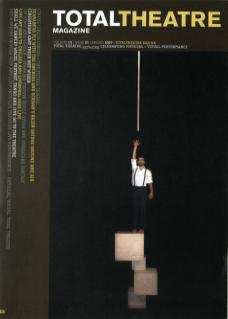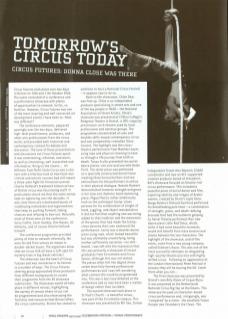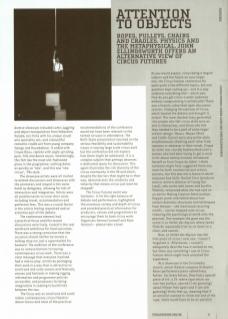Circus Futures took place over two days in Bristol on 10th and 11th October 2006. The event consisted of a conference and a performance showcase with plenty of opportunities to network. So far, so familiar. However, Circus Futures was one of the most inspiring and well conceived art development events I have been to. What was different?
The conference elements, peppered sparingly over the two days, delivered high-level practitioners, producers, and other arts professionals from the circus world, and provided both historical and contemporary context for debate and discussion. The tone of these presentations and discussions set Circus Futures apart: it was entertaining, informal, and warm, as well as interesting, well researched and informative. Bring on the clowns… Ali Williams from NoFit State Circus was a star turn with a hilarious look at how hard-won critical and artistic success had still meant a three-year fight for financial survival. Charlie Holland’s breakneck historical tour of British circus was fascinating stuff. It particularly struck me that the same names kept on appearing over the decades. It was clear there are a dedicated bunch of trailblazing individuals and organisations that keep on pushing forward, taking chances and refusing to bow out. Naturally most of these were at the conference: Gerry Cottle, Carol Gandey, Bim Mason, Ali Williams, and of course Charlie Holland himself.
The conference programme provided plenty of time to network informally. We were ferried from venues en masse in double-decker buses. The organisers know that we circus folk all have a soft spot for mystery trips in big diesel vehicles!
The showcase was the heart of Circus Futures and was innovative in its format in a number of ways. The Circus Futures steering group approached three producers from different backgrounds to curate their programme from the 50 showcase submissions. The showcases would all take place in different venues, highlighting the variety of venues where circus can be programmed and also showcasing the facilities and resources that Bristol offers the circus community. Bristol has stated its ambition to host a National Circus Festival – it appears ripe to do so.
Back to the showcases. Chloe Dear was first up. Chloe is an independent producer specialising in street arts and one of the key people in NASA – the National Association of Street Artists. Chloe’s showcase was presented at Clifton College’s Redgrave Theatre in Bristol, a 300-capacity proscenium-arch theatre used by local professional and amateur groups. The programme concentrated on solo and doubles skills-based contemporary circus and was compered by comedian Steve Cousins. The highlight was the circus-theatre performance from Matilda Leyser, using rope and physical clowning to take us through a life journey from birth to death. Tanya Scully presented two aerial dance pieces: one solo and one with Helen Finch. The latter piece was performed on a specially constructed aerial frame creating three horizontal bars and two vertical bars for the performers to utilise in their physical dialogue. Natalie Reckert demonstrated immense strength and grace in her slow and rhythmic hand-balancing piece. Miguel Munoz rather ambitiously took on the archetypal tramp-clown persona for his combination of sleight of hand, juggling, and object manipulation. It did not feel that anything new was being added to that tradition and the awareness of the greats that had made the tramp-clown persona their own weakened the performance. Levity was a doubles dance piece using rope, which looked beautiful but was ultimately unsatisfying, being neither sufficiently narrative- nor skill-based. I was left with the impression that this was primarily a showcase of recent graduates from Circomedia and Circus Space, although this was not stated. The pieces often felt like degree shows rather than fully formed professional performances and I was left wondering what context this could be programmed into. This was a key issue debated at the conference and so may have been a matter of design rather than accident.
The second showcase took place in St Paul’s Church – a beautiful venue, now part of the Circomedia campus. This showcase was presented by Bill Gee, former Independent Street Arts Network (ISAN) coordinator and now an ACE-supported creative producer based at Artsadmin. Bill’s showcase focused on theatre-led circus performance. This included a powerful piece of aerial dance and film, exploring identity and images of Arabic women, created by Shunt’s Layla Rosa. Bongo Bolero’s Richard Durnford performed his breathtaking pole show – a combination of strength, grace, and death-defying bravado that had the audience gasping. Zu Aerial Theatre performed their new dance piece Little Red Dress, which, while it had some beautiful moments, would still benefit from more tension and drama between the two characters. The highlight of the showcase, and of the event, came from a new young company called Ockham’s Razor. This was one of the most successful attempts at integrating high-quality theatre practice with highly skilled circus. Following an appearance at the London International Mime Festival in January they will be touring the UK. Catch them when you can…
The final showcase was presented by Bristol’s own Billy Alwen of Cirque Bijou. It was presented at the Netherlands National Circus Big Top on the Downs. This showcase focused on character-based circus performance and, intriguingly, was ‘compered’ by a mime: the excellent Fraser Hooper aka Strawberry the Clown. The diverse showcase included comic juggling and object manipulation from Sebastien Valade; Jon Hicks with his unique visual arts speciality act; and a beautiful romantic cradle act from young company Swings and Roundabout. It ended with Cirque Bijou, replete with angle-grinding, pyro, film and dance music. Interestingly, this felt like the most old-fashioned piece in the programme: nothing dates as quickly as ‘new’, and this was ‘new circus’, ’90s style.
The showcase artists were all invited to attend discussions and showcases with the promoters and stayed in the same hotel as delegates, allowing for lots of interaction and integration. Artists were all paid bursaries to cover their costs including travel, accommodation and performer fees. This was a crucial factor in the artists feeling respected and an essential part of the debate.
The conference element had a practical focus and this meant discussions were lively, rooted in the real world and ambitious for hard outcomes. There was a strong conviction that the occasion should neither be merely a talking shop nor just a supermarket for bookers! The ambition of the conference was to remove barriers to touring contemporary circus work. There was a clear message that everyone involved had a role to play: artists by packaging their work in a way that is attractive to small and mid scale venues and festivals; venues and festivals in making rigging information and programme policies accessible; and producers for being imaginative in seeking to build links between the two.
The focus was on small and mid scale indoor contemporary circus/theatre/ dance fusion and most of the practical recommendations of the conference would not have been relevant to the tented circuses in attendance. The NoFit State presentation touched on the serious feasibility and sustainability issues in touring large scale circus work but the conference did not explore how these might be addressed. It is a complex subject that perhaps deserves a dedicated space for discussion. This again illustrates the rich diversity of the circus community in the UK and which, despite the barriers that might be in their way, demonstrates the solidarity and tenacity that means circus just wont be stopped!
The Circus Futures event was fantastic. It hit the right balance of debate and performance, highlighted the enormous variety and depth of circus and provided practical information for producers, venues and programmers to encourage them to book circus work. Organisers Verena Cornwall and Kate Hartoch – please take a bow!


